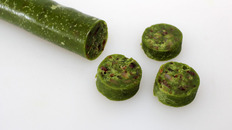Meats and Sausages
Erbswurst
Erbswurst is German highly nutritional sausage made with pea flour, pork meat, pork belly, fat and onions. It has been invented in 1867 by Johann Heinrich Grüneberg in Berlin and has been made and sold in Germany ever since. When Erbswurt is mixed with water an instant pea soup is created.
| Meats | Metric | US |
|---|---|---|
| Fresh pork belly or smoked bacon | 350 g | 0.77 lb |
| Hard fat | 250 g | 0.55 lb |
| Pea flour | 400 g | 0.88 lb |
Ingredients per 1000g (1 kg) of meat
| Salt | 18 g | 3 tsp |
| Pepper | 2.0 g | 1 tsp |
| Marjoram | 1.0 g | 1/2 tsp |
| Nutmeg | 0.3 g | 1/4 tsp |
| Thyme | 0.3 g | 1/4 tsp |
| Onion | 30 g | 1/2 onion |
Instructions
- Dice fresh pork belly or smoked bacon into 1/4" (5 mm) cubes.
- Dice hard fat (or fat trimmings) into 1/4" (5 mm) cubes.
- Chop onion finely.
- Fry both belly and fat cubes until gold, stirring often.
- Fry onion in some fat until gold. Don't make it brown as it will taste bitter.
- Heat up a pot on low fire and start adding pea flour stirring continuously. Add all spices, keep on stirring.
- Add all meats, fat included, stir together and keep the mass warm otherwise it will harden.
- Stuff firmly into 40 mm casings making 8" (20 cm) straight links.
- There is no need for cooking.
Notes
Making Smoked Bacon (if used)
Ingredients for 1 kg (2.2 lb) of fresh pork belly: Salt, 18 g (3 tsp) Cure #1, 2 g (3/4 tsp)
Mix cure 1 with salt and rub into cut of bacon on all sides. Place in refrigerator for 72 hours. Apply smoke for 2 hours.
If smoked bacon is used decrease the amount of salt in the recipe to 12 g (2 tsp).
100 g (3.5 oz) of Erbswurst mixed with 750 ml (3 cups) of water will make delicious pea soup.


















